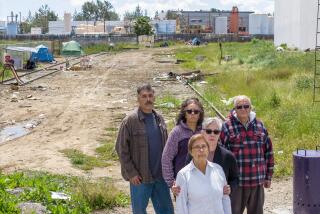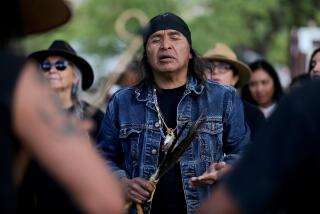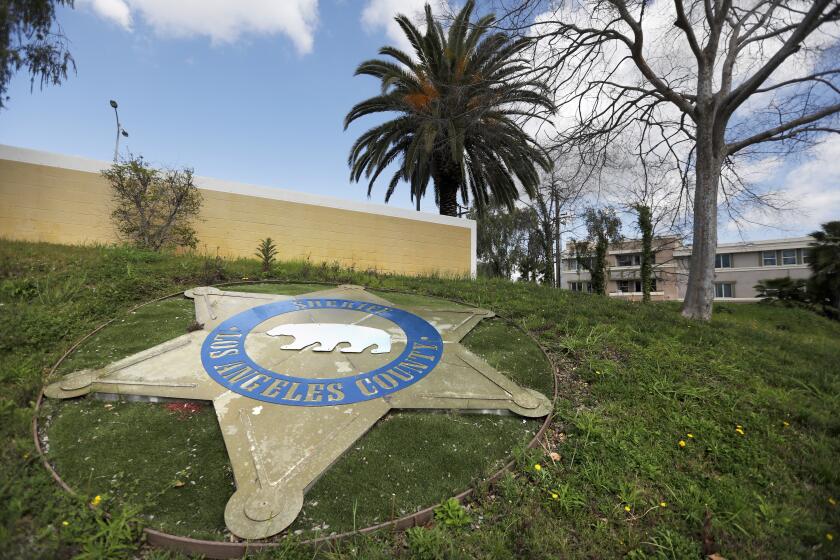Historic apology over sacred site
SACRAMENTO — The top executive of California’s biggest utility Thursday apologized to an Arizona Indian tribe, promising to atone for the company’s desecration of a sacred site the tribe considers a portal to the afterlife.
Chief Executive Thomas King said Pacific Gas & Electric Co. “regrets the spiritual consequences to the tribe” when it built a $15-million water treatment plant in the Mojave Desert, west of the California-Arizona border.
The site known as Topock Maze once covered more than 50 acres of sage-dotted desert. There on a bluff above the Colorado River, an ancient pattern of lines inscribed on the desert floor marks the pathway to heaven for Indians who live nearby.
On Thursday, at a historic gathering, tribal members, other Native Americans, state officials and utility executives announced they had reached an unprecedented agreement.
The Indians dropped their lawsuit against the utility, and PG&E apologized and said it should have paid closer attention to the Indians’ spiritual beliefs before building the plant. It promised to be more sensitive and to relocate the plant eventually away from the maze.
Protecting the maze is crucial to the survival of the 1,100-person Fort Mojave Indian tribe, tribal Chairwoman Nora McDowell told the crowd. “We have a responsibility not only to the past and present but to the future,” she said. “It wasn’t easy getting a corporation to understand, to recognize and to accept this.”
Attorneys for the tribe, guests at the ceremony and even PG&E called the agreement and the utility’s apology a first. Company spokesman Jon Tremayne said he could not recall PG&E ever making an apology of “that magnitude.”
Alison Harvey, director of the California Tribal Business Alliance, said she was struck by “the incredibly touching display on both sides” and “the fact that the PG&E executive officer was prepared to come forward and participate in that way.”
A clash of beliefs
The tribe, whose reservation covers parts of Arizona and Nevada near Needles, Calif., considers the ancient pattern of lines as the destination of a soul’s lifetime journey.But that belief clashed with PG&E and state environmental regulators in the last decade as they moved to address problems in the area caused by a massive plume of polluted groundwater under a natural gas compressor station.
Fearing the plume could contaminate the Colorado River and endanger drinking water supplies for 22 million people in Southern California and Arizona, the state and utility pressed ahead with plans despite the Indians’ concern.
In early 2004, the state and the company began installing test wells and pollution control equipment in the area of the maze without consulting the tribe. Work on the plant began in late 2004, and it began operating in July 2005.
The tribe sued in Sacramento County Superior Court, claiming San Francisco-based PG&E and the California Department of Toxic Substances Control violated state environmental laws by not exploring alternatives to building a 7,000-square-foot treatment plant.
The legal battle ended Thursday with apologies from PG&E and tears of joy from tribal leaders. CEO King and the Schwarzenegger administration’s top toxics regulator joined Chairwoman McDowell to announce a settlement.
More than a dozen women in full skirts and colorful shawls danced and chanted as an Indian elder purified the event with smoke from burning sage and an eagle feather.
The agreement calls for no payment of damages. It commits PG&E to remove the treatment plant as part of a final plan to clean up groundwater tainted by hexavalent chromium — the same toxin found under a similar PG&E facility in Hinkley, Calif., made famous by the film “Erin Brockovich.”
The legal settlement also deeds ownership of the maze to the tribe and pledges that the Indians will be consulted before doing any new engineering work.
The existing plant will remain in operation, treating polluted water, until a replacement can be built away from the maze.
The accord — signed by the tribe, PG&E and the state — required the utility to make a “public statement” that it “regrets our failure to sufficiently understand the tribe’s belief, and apologizes.”
The comments by PG&E’s King at the ceremony, however, were “truly from the heart” and were “deeper than just a press conference,” company spokesman Tremayne said.
A model for other states
The words of state Toxic Substances Control Director Maureen Gorsen also went far beyond the legal boilerplate spelled out in the settlement agreement.“This is a change in the way we do business,” Gorsen said in an interview. “It’s the left brain and right brain and the heart working together instead of just being an engineering decision.”
Gorsen called the agreement a model for other states and the federal government in “learning how to cooperate with the tribes.” The agreement allows the two sides to collaborate to protect the river from potential contamination without doing harm to the Fort Mojave’s culture and spiritual well-being.
The project, which PG&E said had cost “tens of millions of dollars” since 1998, is needed to treat at least 198 million gallons of water laced with hexavalent chromium that the utility dumped into the ground from 1951 to 1969.
The chemical compound, a known carcinogen, was used to prevent corrosion and retard the growth of mold in a cooling tower at a compressor station that pushes natural gas through a major pipeline to Southern California.
At least one monitoring well has found concentrations of hexavalent chromium only 60 feet from the Colorado River. Both the state and PG&E, however, stressed that the treatment plant was pulling the plume back from the river and that no toxins had been detected in the Colorado.
Tribal attorneys were pleased with Thursday’s announcement. “This is a recognition that these places are worthy of respect and protection,” said Courtney Coyle, who specializes in cases involving Native American sacred sites.
Coyle noted that the settlement of the Fort Mojave lawsuit was the latest in a series of legal victories for Indians.
Years battling in courts and in the media are starting to pay off for the tribes, said Christopher McLeod, a Santa Cruz County filmmaker and an activist for protecting sacred sites.
“The portal to the afterlife is a very serious place and has been that way for thousands of years,” he said.
“It’s historic that PG&E would acknowledge that and do the right thing.”
marc.lifsher@latimes.com
More to Read
Start your day right
Sign up for Essential California for news, features and recommendations from the L.A. Times and beyond in your inbox six days a week.
You may occasionally receive promotional content from the Los Angeles Times.







